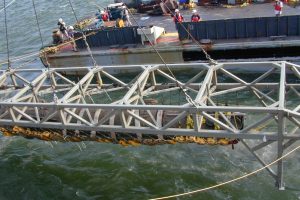NORTH CHARLESTON – The H.L. Hunley submarine has joined an elite global network of historical landmarks, which includes the Liberty Bell and Eiffel Tower. The recognition was presented Nov. 29 by ASM International–The Materials Information Society at the Warren Lasch Conservation Center laboratory. The laboratory houses the Clemson University Conservation Center, where an international team is developing new technologies to restore the 1863 vessel.
The ASM Historical Landmark Award recognizes sites for historic contributions to metallurgical and materials engineering advancements or for the application of materials in significant structures or vessels. The nomination was endorsed by the U.S. Naval Research Laboratory (NRL) and the Western Australian Museum among many others.
“The Hunley was selected for this award because of what it represents, both as a forerunner for generations of modern submersible craft, and as a great achievement in the history of materials technology,” said Jon Tirpak, ASM International Trustee, who presented the award.
The U.S. Naval Research Laboratory nominated the Hunley for two reasons: it was the first submarine to sink an enemy vessel and it represents a unique design and use of materials. The Navy is particularly interested in the research that is emerging from the Hunley restoration.
“This research represents cutting edge technology, especially with respect to chloride extraction and metal preservation,” said Michael J. Drews, Clemson Conservation Center director. The research discoveries have the potential to protect ships and metal structures exposed to saltwater.
John Kelly, executive director of the Clemson Restoration Institute, said, “I wonder if the builders of the Hunley imagined that nearly two centuries later we would be learning new science based on what they had done.”
The award was accepted by Senator Glenn McConnell, chairman of the Hunley Commission and on behalf of Friends of the Hunley. “We are honored to receive the ASM award, which acknowledges the Hunley as an international historical landmark. Most importantly, it recognizes the work we have conducted to bring science and history together to discover the Hunley’s story as well as expand the bounds of technology.”
In receiving the 2007 ASM Historical Landmark Award, the Hunley joins 118 other such landmarks, which are located in Brazil, Canada, Mexico, Austria, Finland, France, Germany, Italy, Spain, Sweden, the United Kingdom, Japan, India and throughout the United States.
The Hunley Project
On the evening of February 17, 1864, the H. L. Hunley became the world’s first successful combat submarine by sinking the USS Housatonic. After signaling to shore that the mission had been accomplished, the submarine and her crew of eight mysteriously vanished. Lost at sea for over a century, the Hunley was located in 1995 by Clive Cussler’s National Underwater and Marine Agency (NUMA). The innovative hand-cranked vessel was raised in 2000 and delivered to the Warren Lasch Conservation Center, where an international team of scientists are at work to conserve the submarine for future generations and piece together clues to solve the mystery of her disappearance. The Hunley Project is conducted through a partnership with the South Carolina Hunley Commission, Clemson University Restoration Institute, Naval Historical Center, and Friends of the Hunley.


